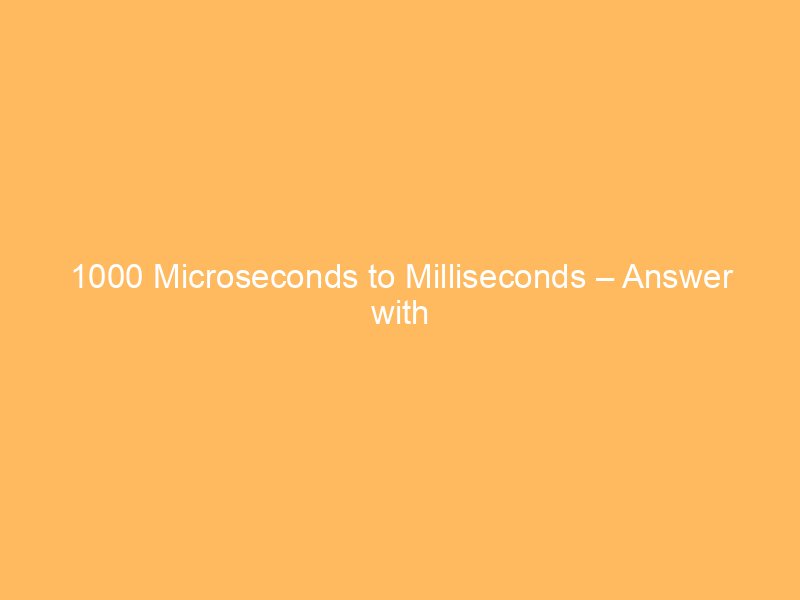1000 microseconds is equal to 1 millisecond.
To convert microseconds to milliseconds, you divide the number of microseconds by 1000 because there are 1000 microseconds in a single millisecond. So, 1000 microseconds divided by 1000 equals 1 millisecond.
Conversion Tool
Result in milliseconds:
Conversion Formula
The conversion from microseconds (μs) to milliseconds (ms) is done by dividing the microseconds value by 1000. This works because 1 millisecond equals exactly 1000 microseconds. The formula is:
Milliseconds = Microseconds ÷ 1000
For example, if you have 1000 microseconds:
- Divide 1000 by 1000.
- 1000 ÷ 1000 = 1.
- So, 1000 microseconds = 1 millisecond.
This formula works because time units are related by powers of ten, so converting smaller units to larger units requires division by the factor between them.
Conversion Example
- Convert 2500 microseconds to milliseconds:
- Divide 2500 by 1000.
- 2500 ÷ 1000 = 2.5 milliseconds.
- Convert 500 microseconds to milliseconds:
- Divide 500 by 1000.
- 500 ÷ 1000 = 0.5 milliseconds.
- Convert 12345 microseconds to milliseconds:
- Divide 12345 by 1000.
- 12345 ÷ 1000 = 12.345 milliseconds.
- Convert 999 microseconds to milliseconds:
- Divide 999 by 1000.
- 999 ÷ 1000 = 0.999 milliseconds.
- Convert 750 microseconds to milliseconds:
- Divide 750 by 1000.
- 750 ÷ 1000 = 0.75 milliseconds.
Conversion Chart
| Microseconds (μs) | Milliseconds (ms) |
|---|---|
| 975.0 | 0.975 |
| 980.0 | 0.980 |
| 985.0 | 0.985 |
| 990.0 | 0.990 |
| 995.0 | 0.995 |
| 1000.0 | 1.000 |
| 1005.0 | 1.005 |
| 1010.0 | 1.010 |
| 1015.0 | 1.015 |
| 1020.0 | 1.020 |
| 1025.0 | 1.025 |
This chart shows the conversion of microseconds values near 1000 to their equivalent in milliseconds. To find the milliseconds for a microseconds value, look at the left column, then read across the corresponding milliseconds value in the right column.
Related Conversion Questions
- How many milliseconds are in 1000 microseconds?
- What is the formula to convert 1000 microseconds into milliseconds?
- Is 1000 microseconds equal to 1 millisecond or less?
- How do I convert 1000 μs to ms using a calculator?
- What does 1000 microseconds convert to in terms of milliseconds?
- Can 1000 microseconds be expressed as milliseconds exactly?
- How much time is 1000 microseconds in milliseconds?
Conversion Definitions
Microseconds: A microsecond is a unit of time equal to one millionth (10⁻⁶) of a second. It is used to measure very short durations, commonly in electronics, computing, and scientific experiments where precise time intervals matters greatly.
Milliseconds: A millisecond is a unit of time equal to one thousandth (10⁻³) of a second. It is commonly used in measuring time intervals in everyday life, like in timing events, computing processes, or scientific measurements requiring finer resolution than seconds.
Conversion FAQs
Why do I divide microseconds by 1000 to get milliseconds?
You divide by 1000 because 1 millisecond contains exactly 1000 microseconds. Since microseconds are smaller units, converting them to a larger unit needs division by how many smaller units fit into one larger unit. So dividing microseconds by 1000 converts it to milliseconds.
Can I convert milliseconds back to microseconds?
Yes, to convert milliseconds to microseconds, multiply the number of milliseconds by 1000. This reverses the division used for microseconds to milliseconds, because 1 millisecond equals 1000 microseconds.
Are microseconds and milliseconds used in everyday life?
Milliseconds are common in everyday timing, like measuring response times or intervals in sports and computing. Microseconds are less common for daily use but important in technical fields such as electronics, telecommunications, and scientific timing where very precise time intervals are needed.
What happens if I forget to convert units properly between microseconds and milliseconds?
Forgetting to convert properly can cause timing errors in calculations, such as overestimating or underestimating time intervals by a factor of 1000. This can lead to mistakes in systems relying on precise timing, like software performance or scientific measurements.
Do all devices measure time in microseconds and milliseconds?
Not all devices measure time in such fine units. Many devices use milliseconds or seconds, but high-speed electronics and specialized instruments may use microseconds or even smaller units to capture rapid events accurately.





